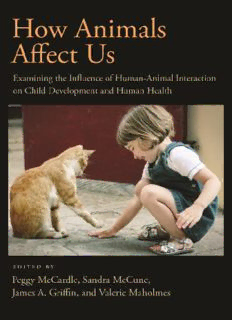
How Animals Affect Us: Examining the Influence of Human-Animal Interaction on Child Development and Human Health PDF
Preview How Animals Affect Us: Examining the Influence of Human-Animal Interaction on Child Development and Human Health
How Animals Affect Us 12142-00_FM_rev4.qxd 8/26/10 2:14 PM Page ii How Animals Affect Us Examining the Influence of Human–Animal Interaction on Child Development and Human Health edited by Peggy McCardle, Sandra McCune, James A. Griffin, and Valerie Maholmes A M E R I C A N P S Y C H O L O G I C A L A S S O C I AT I O N WA S H I N G TO N, D C 12142-00_FM_rev4.qxd 8/26/10 2:14 PM Page iv Copyright © 2011 by the American Psychological Association. All rights reserved. Except as permitted under the United States Copyright Act of 1976, no part of this publication may be reproduced or distributed in any form or by any means, including, but not limited to, the process of scanning and digitization, or stored in a database or retrieval system, without the prior written permission of the publisher. Published by To order American Psychological Association APA Order Department 750 First Street, NE P.O. Box 92984 Washington, DC 20002 Washington, DC 20090-2984 www.apa.org Tel: (800) 374-2721; Direct: (202) 336-5510 Fax: (202) 336-5502; TDD/TTY: (202) 336-6123 Online: www.apa.org/pubs/books/ E-mail: [email protected] In the U.K., Europe, Africa, and the Middle East, copies may be ordered from American Psychological Association 3 Henrietta Street Covent Garden, London WC2E 8LU England Typeset in Goudy by Circle Graphics, Inc., Columbia, MD Printer: Edwards Brothers, Inc., Ann Arbor, MI Cover Designer: Berg Design, Albany, NY The opinions and statements published are the responsibility of the authors, and such opinions and statements do not necessarily represent the policies of the American Psychological Association. Library of Congress Cataloging-in-Publication Data How animals affect us : examining the influence of human-animal interaction on child development and human health / edited by Peggy McCardle ... [et al.].—1st ed. p. cm. Includes bibliographical references and index. ISBN-13: 978-1-4338-0865-4 ISBN-10: 1-4338-0865-X ISBN-13: 978-1-4338-0866-1 (e-book) ISBN-10: 1-4338-0866-8 (e-book) 1. Pets—Therapeutic use. 2. Human-animal relationships. 3. Child development. I. McCardle, Peggy D. RC489.P47H69 2011 616.89'1658—dc22 2010020978 British Library Cataloguing-in-Publication Data A CIP record is available from the British Library. Printed in the United States of America First Edition 12142-00_FM_rev4.qxd 8/26/10 2:14 PM Page v The pet, in a sense, becomes the mirror in which the child sees him(her)self wanted and loved not for what he (or she) should be or might be or might have been but for what he (or she) is. —B. M. Levinson. Pet-Oriented Child Psychotherapy (2nd ed.) 12142-00_FM_rev4.qxd 8/26/10 2:14 PM Page vi 12142-00_FM_rev4.qxd 8/26/10 2:14 PM Page vii CONTENTS Contributors ............................................................................................... xi Foreword ................................................................................................... xiii Mark T. Greenberg Acknowledgments ..................................................................................... xv Human–Animal Interaction Research: An Introduction to Issues and Topics...................................................................................... 3 James A. Griffin, Sandra McCune, Valerie Maholmes, and Karyl Hurley I. Methodology......................................................................................... 11 Chapter 1. Principles for Human–Animal Interaction Research.... 13 Gail F. Melson Chapter 2. Establishing the Effectiveness of Animal-Assisted Therapies: Methodological Standards, Issues, and Strategies................................................................. 35 Alan E. Kazdin vii 12142-00_FM_rev4.qxd 8/26/10 2:14 PM Page viii Chapter 3. Promises and Pitfalls of Hormone Research in Human–Animal Interaction...................................... 53 Kerstin Uvnäs-Moberg, Linda Handlin, and Maria Petersson II. Human–Animal Interaction and Child Development..................... 83 Chapter 4. How Very Young Children Think About Animals............................................................... 85 Judy S. DeLoache, Megan Bloom Pickard, and Vanessa LoBue Chapter 5. The Other Side of the Bond: Domestic Dogs’ Human-Like Behaviors................................................ 101 Clive D. L. Wynne, Nicole R. Dorey, and Monique A. R. Udell Chapter 6. Animal Abuse and Developmental Psychopathology Frank R. Ascione and Mika Maruyama.......................... 117 III. Human–Animal Interaction and Human Health......................... 137 Chapter 7. Childhood Obesity and Human–Animal Interaction.................................................................... 139 Jo Salmon and Anna Timperio Chapter 8. Health Correlates of Pet Ownership From National Surveys................................................. 153 Bruce Headey and Markus Grabka Chapter 9. Physiological Correlates of Health Benefits From Pets...................................................................... 163 Erika Friedmann, Sandra B. Barker, and Karen M. Allen Chapter 10. Animal-Assisted Intervention in Health Care Contexts.............................................. 183 Rebecca A. Johnson viii CONTENTS 12142-00_FM_rev4.qxd 8/26/10 2:14 PM Page ix Afterword: An Agenda for Future Research............................................ 193 Peggy McCardle, Sandra McCune, Layla Esposito, Valerie Maholmes, and Lisa Freund Appendix: A Resource for Studying Human–Animal Interaction......... 203 Tim Adams Index ....................................................................................................... 215 About the Editors ................................................................................... 227 CONTENTS ix
Description: